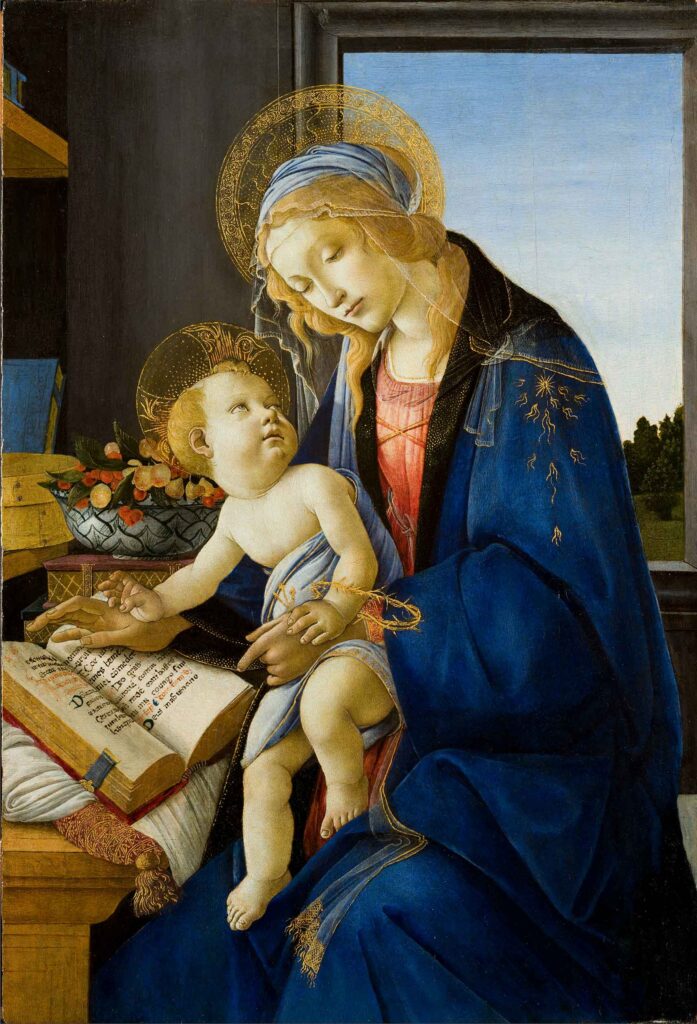Madonna and Child
Sandro Botticelli , 1480 - 1481
Description

Also known as the Madonna of the Book, this painting depicts the Virgin and Child reading a book. The layout and decoration of the pages suggest that it might be a Book of Hours, one of those devotional manuals intended for laypeople that gained widespread popularity between the 13th and 16th centuries. Next to the book, on which Mary’s hand rests, there are other books and various objects giving the image a domestic tone. The pyramidal composition of the sacred figures leaves space to an open window, from which a warm light comes.
The light enveloping the Madonna and Child, however, does not seem to have a natural origin, but rather appears to emanate from the figures themselves, transforming the simple interior into a mystical setting. Even the fruits in the majolica bowl likely have symbolical meanings: the cherries allude to the blood of Christ, the plums to the sweetness of the affection between Mother and Son, the figs to the Salvation or the Resurrection of Christ. The three nails in Jesus’ hand and the crown of thorns on his arm serve as reminders of his future Passion.
Dating around 1482-1483, the work was probably painted for the private devotion of a very prestigious patron, as evident not only in the extremely high quality of the painting but also in the use of very precious materials, such as the pure gold used for the halos and other details, and the blue of Mary’s mantle made with crushed lapis lazuli. In same years, Botticelli painted masterpieces as the Birth of Venus or the Spring.
Data Sheet
Author
Sandro Botticelli, 1445-1510
Date
1480 - 1481
Material and technique
Tempera on panel
Measures
39.6 cm × 58 cm
Acquisition
legato Gian Giacomo Poldi Pezzoli, 1879
Inventory number
0443
location
Golden Room
The Golden Room is the most important room in the Museum and houses the masterpieces of painting from the Poldi Pezzoli collection. Conceived according to the dictates of the Renaissance style, it was designed to be the hall of honor of Gian Giacomo’s apartment. After the collector’s death, Giuseppe Bertini carried on the work: unfortunately, both the gilded coffered ceiling, the frescoes, painted by Bertini himself, and the damask fabric decorations that lined the walls were destroyed by bombing. The current museographic arrangement dates back to the 1990s. Among the works on display are the Portrait of a Lady attributed to Piero del Pollaiolo and which has become a symbol of the museum, Bellini’s Imago Pietatis, Botticelli’s Lamentation over the Dead Christ, Mantegna’s Madonna and Child, and Piero della Francesca’s Saint Nicholas of Tolentino. The display case separating the Salone Dorato from the Sala degli Stucchi houses the porcelain and majolica collections.
collection
Paintings
The Museum hosts over 300 paintings. Among them, many Italian works from the Renaissance: masterpieces from Tuscany (Botticelli, Piero della Francesca, Pollaiuolo), Lombardy (Luini, Boltraffio, Solario) and Veneto (Bellini, Mantegna). Important is also the group of 18th century Italian painting (Guardi, Canaletto, Tiepolo, Fra Galgario). In the collection, there are mainly portraits and small size paintings.
